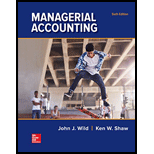
1.
1.
Explanation of Solution
Table showing total departmental overhead cost of model 145 and model 212:
| Activity | Overhead rate ($) | Value of activity driver of model 145 | Value of activity driver for model 212 | Overhead cost of model 145 ($) | Overhead cost of model 212 ($) |
| Changeover | 625.0 | 400 | 400 | 250,000 | 250,000 |
| Machining | 46.5 | 1,800 | 4,200 | 83,700 | 195,300 |
| Setups | 1,875.0 | 60 | 60 | 112,500 | 112,500 |
| Welding | 60.0 | 800 | 2,200 | 48,080 | 132,220 |
| Inspecting | 300.0 | 400 | 300 | 120,000 | 90,000 |
| Reworks | 250.0 | 160 | 140 | 40,000 | 35,000 |
| Purchasing | 300.0 | 300 | 150 | 90,000 | 45,000 |
| Space | 6.4 | 1,500 | 3,500 | 9,600 | 22,400 |
| Utilities | 13.0 | 1,500 | 3,500 | 19,500 | 45,500 |
| Total overhead cost | 773,380 | 927,920 |
Formula to compute overhead cost per unit is,
Model 145
Given,
Total units produced are 1,500.
Substitute 1,500 units for produced units and $773,380 for total overhead cost in the formula.
Model 212
Given,
Totalunits produced are 3,500.
Substitute 3,500 units for produced units and $927,920 for total overhead cost in the formula.
Hence, overhead cost per unit for product 145 is $515.59 and for product 212 is $265.12.
Working notes:
Formula to calculate departmental overhead rate is,
Calculation of overhead rate for changeover activity,
Calculation of overhead rate for machining activity,
Calculation of overhead rate for setups activity,
Calculation of overhead rate for welding activity,
Calculation of overhead rate for inspecting activity,
Calculation of overhead rate for rework activity,
Calculation of overhead rate for purchasing activity,
Calculation of overhead rate for providing space activity,
Calculation of overhead rate for providing utility activity,
2.
Total cost per unit for each product line.
2.
Explanation of Solution
Formula to compute total cost per unit is,
Model 145
Given,
Direct labor and material cost per unit is $250.
Overhead cost per unit is $515.59.
Substitute $250 for direct labor and material cost per unit and $515.59 for overhead cost per unit in the formula.
Model 212
Given,
Direct labor and material cost per unit is $180.
Overhead cost per unit is $265.12.
Substitute $180 for direct labor and material cost per unit and $265.12 for overhead cost per unit in the formula.
Hence, total cost per unit for product 145 is $765.59 and for product 212 is $445.12.
3.
Profit or loss per unit for each model.
3.
Explanation of Solution
Formula to compute profit or loss per unit is,
Model 145
Given,
Market price per unit is $820.
Total cost per unit is $765.59.
Substitute $820 for market price per unit and $765.59 for total cost per unit in the formula.
Model 212
Given,
Market price per unit is $480.
Total cost per unit is $445.12.
Substitute $480 for market price per unit and $445.12 for total cost per unit in the formula.
Hence, profit per unit for product 145 is $54.41 andfor product 212 is $34.88.
Want to see more full solutions like this?
Chapter 4 Solutions
Managerial Accounting
- What is the total owner's equity?arrow_forwardHii, Tutor Give answer to this Problemarrow_forwardThe Cambridge Manufacturing's next expected dividend, D1, is $2.85; its growth rate is 6.2 percent, and its stock currently sells for $46.30. New stock can be sold to net the firm $43.05 per share. a. What is Cambridge's percentage flotation cost? b. What is Cambridge's cost of new common stock? Provide answerarrow_forward
- Can you explain the process for solving this financial accounting question accurately?arrow_forwardIf Sierra Manufacturing had their total liabilities increased by $8,400 and stockholders' equity decreased by $3,700 during a period of time. Then total assets must have changed by what amount and direction during that same period? Helparrow_forwardPlease explain the solution to this general accounting problem with accurate principles.arrow_forward
- Quaker Industries has a cost of goods manufactured of $550,000, beginning finished goods inventory of $150,000, and ending finished goods inventory of $200,000. The cost of goods sold is: A. $400,000 B. $500,000 C. $550,000 D. $600,000arrow_forwardA change in accounting estimate is applied? (A) Retrospectively (B) Neither prospectively nor retrospectively (C) Both prospectively and retrospectively (D) Prospectively solve thisarrow_forwardIf Sierra Manufacturing had their total liabilities increased by $8,400 and stockholders' equity decreased by $3,700 during a period of time. Then total assets must have changed by what amount and direction during that same period?arrow_forward
- Hello teacher please give me solutionarrow_forwardA change in accounting estimate is applied? (A) Retrospectively (B) Neither prospectively nor retrospectively (C) Both prospectively and retrospectively (D) Prospectively MCQarrow_forwardPlease provide the solution to this general accounting question with accurate financial calculationsarrow_forward

 AccountingAccountingISBN:9781337272094Author:WARREN, Carl S., Reeve, James M., Duchac, Jonathan E.Publisher:Cengage Learning,
AccountingAccountingISBN:9781337272094Author:WARREN, Carl S., Reeve, James M., Duchac, Jonathan E.Publisher:Cengage Learning, Accounting Information SystemsAccountingISBN:9781337619202Author:Hall, James A.Publisher:Cengage Learning,
Accounting Information SystemsAccountingISBN:9781337619202Author:Hall, James A.Publisher:Cengage Learning, Horngren's Cost Accounting: A Managerial Emphasis...AccountingISBN:9780134475585Author:Srikant M. Datar, Madhav V. RajanPublisher:PEARSON
Horngren's Cost Accounting: A Managerial Emphasis...AccountingISBN:9780134475585Author:Srikant M. Datar, Madhav V. RajanPublisher:PEARSON Intermediate AccountingAccountingISBN:9781259722660Author:J. David Spiceland, Mark W. Nelson, Wayne M ThomasPublisher:McGraw-Hill Education
Intermediate AccountingAccountingISBN:9781259722660Author:J. David Spiceland, Mark W. Nelson, Wayne M ThomasPublisher:McGraw-Hill Education Financial and Managerial AccountingAccountingISBN:9781259726705Author:John J Wild, Ken W. Shaw, Barbara Chiappetta Fundamental Accounting PrinciplesPublisher:McGraw-Hill Education
Financial and Managerial AccountingAccountingISBN:9781259726705Author:John J Wild, Ken W. Shaw, Barbara Chiappetta Fundamental Accounting PrinciplesPublisher:McGraw-Hill Education





